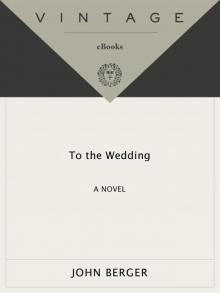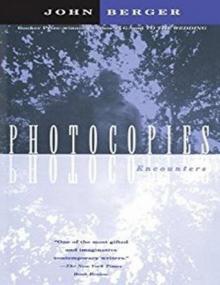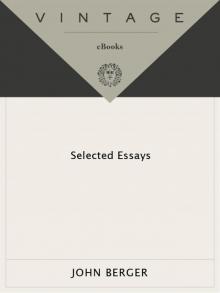- Home
- John Berger
Selected Essays of John Berger
Selected Essays of John Berger Read online
Selected Essays
John Berger
John Berger was born in London in 1926. His many books, innovative in form and far-reaching in their historical and political insight, include the Booker Prize–winning novel G. John Berger now lives and works in a small village in the French Alps.
ALSO BY JOHN BERGER
Into Their Labours
(Pig Earth, Once in Europa, Lilac and Flag: A Trilogy)
A Painter of Our Time
Permanent Red
The Foot of Clive
Corker’s Freedom
A Fortunate Man
Art and Revolution
The Moment of Cubism and Other Essays
The Look of Things: Selected Essays and Articles
Ways of Seeing
Another Way of Telling
A Seventh Man
G.
About Looking
And Our Faces, My Heart, Brief as Photos
The Sense of Sight
The Success and Failure of Picasso
Keeping a Rendezvous
To the Wedding
King
Photocopies
The Shape of a Pocket
FIRST VINTAGE INTERNATIONAL EDITION, MARCH 2003
Copyright © 2001 by John Berger
Introduction copyright © 2001 by Geoff Dyer
All rights reserved under International and Pan-American Copyright Conventions. Published in the United States by Vintage Books, a division of Random House, Inc., New York, and simultaneously in Canada by Random House of Canada Limited, Toronto. Originally published in hardcover in Great Britain by Bloomsbury Publishing Plc, London, and subsequently published in hardcover in the United States by Pantheon Books, a division of Random House, Inc., New York, in 2001.
Vintage is a registered trademark and Vintage International and colophon are trademarks of Random House, Inc.
All of the essays except two were taken from the following collections: Toward Reality (Alfred A. Knopf, 1962) copyright © 1960 by John Berger. The Moment of Cubism (Pantheon Books, 1969) copyright © 1969 and renewed 1997 by John Berger. The Look of Things (The Viking Press, 1974) copyright © 1972 by John Berger. About Looking (Pantheon Books, 1980) copyright © 1980 by John Berger. The Sense of Sight (Pantheon Books, 1985) copyright © 1985 by John Berger. Keeping a Rendezvous (Pantheon Books, 1992) copyright © 1988, 1991 by John Berger.
The Library of Congress has cataloged
the Pantheon edition as follows:
Berger, John.
[Selections. 2002]
Selected essays / John Berger; edited by Geoff Dyer.
p. cm.
PR6052.E564 A6 2002 824’.914—dc21 2001036673
eISBN: 978-0-307-49070-4
www.vintagebooks.com
v3.1_r1
Contents
Cover
About the Author
Other Books by This Author
Title Page
Copyright
Editor’s Introduction
From Permanent Red (1960) (US title Toward Reality)
Preface to the 1979 Edition
Introduction
Drawing
Jackson Pollock
Henry Moore
Juan Gris
Jacques Lipchitz
Ossip Zadkine
Fernand Léger
Pablo Picasso
Henri Matisse
Oskar Kokoschka
The Clarity of the Renaissance
The Calculations of Piero
Poussin’s Order
Watteau as the Painter of His Time
The Honesty of Goya
The Dilemma of the Romantics
Millet and Labour
The Politics of Courbet
Gauguin’s Crime
From The Moment of Cubism (1969)
The Moment of Cubism
The Historical Function of the Museum
The Changing View of Man in the Portrait
Art and Property Now
Image of Imperialism
Nude in a Fur Coat Rubens
The Painter in His Studio: Vermeer
Et in Arcadia Ego: Poussin
The Maja Dressed and The Maja Undressed: Goya
Mathias Grünewald
L. S. Lowry
Henri de Toulouse-Lautrec
Alberto Giacometti
Pierre Bonnard
Frans Hals
Auguste Rodin
From The Look of Things (1972)
Peter Peri
Zadkine
Le Corbusier
Victor Serge
Walter Benjamin
Drawings by Watteau
Fernand Léger
Thicker than Water (Corot)
Painting a Landscape
Understanding a Photograph
The Political Uses of Photo-Montage
The Sight of a Man
Revolutionary Undoing
Past Seen from a Possible Future
The Nature of Mass Demonstrations
The Booker Prize Speech
Speech on Accepting the Booker Prize for Fiction (1972)
From About Looking (1980)
Why Look at Animals?
The Suit and the Photograph
Photographs of Agony
Paul Strand
Uses of Photography
The Primitive and the Professional
Millet and the Peasant
Seker Ahmet and the Forest
La Tour and Humanism
Francis Bacon and Walt Disney
An Article of Faith
Between Two Colmars
Courbet and the Jura
Turner and the Barber’s Shop
Rouault and the Suburbs of Paris
Magritte and the Impossible
Romaine Lorquet
Field
From The White Bird (1985) (US title The Sense of Sight)
The White Bird
The Storyteller
The Eaters and the Eaten
On the Bosphorus
The Theatre of Indifference
Modigliani’s Alphabet of Love
The Hals Mystery
In a Moscow Cemetery
Ernst Fischer: A Philosopher and Death
François, Georges and Amélie: A Requiem in Three Parts
Drawn to That Moment
The Eyes of Claude Monet
The Work of Art
Mayakovsky: His Language and His Death [with Anya Bostock]
The Hour of Poetry
Leopardi
The Production of the World
Ulysses
The First and Last Recipe: Ulysses (1991)
From Keeping a Rendezvous (1992)
Note to the Reader
Ev’ry Time We Say Goodbye
That Which Is Held
A Load of Shit
Mother
A Story for Aesop
The Ideal Palace
Imagine Paris
A Kind of Sharing
Christ of the Peasants
A Professional Secret
Ape Theatre
The Opposite of Naked
A Household
Drawing on Paper
Erogenous Zone
The Soul and the Operator
The Third Week of August, 1991
Appendices
Notes
Sources
Editor’s Introduction
John Berger’s achievements as a writer are both widely recognised and – because of their diversity – difficult to grasp. Even admirers tend to know him in only one or two of his many incarnations. The questions ‘Which is his best book?’ or ‘Which book should I read first?’ are unanswerable. It is t
he entire body of work that is remarkable; no single volume represents Berger adequately. However, the occasion of his seventy-fifth birthday, in November 2001, provided a timely opportunity to try to come up with just such a book.
Throughout his working life Berger has written essays. Far from being adjuncts to the main body of work, these essays are absolutely central to it. Many of the ideas in the ground-breaking book and TV series Ways of Seeing – ideas which have since become part of our received cultural knowledge – were presented first and, in some ways, more sensitively, in essays for New Society. Polemical, meditative, radical, always original (‘The moment at which a piece of music begins provides a clue to the nature of all art’), Berger’s essays are, of course, extremely wide-ranging. It is not just that he has written on photographers, artists, thinkers and peasants, on zoos, museums and cities he has travelled to; these diverse concerns are often combined in the course of a single essay. Taken together, however, this signature variegation emphasises the continuities that have underpinned more than forty years of tireless intellectual inquiry and fierce political engagement. Viewed chronologically they do not simply show how his views have changed or how his thought has evolved; they add up to a kind of vicarious autobiography and a history of our time as refracted through the prism of art.
More than any other writer of the post-war period, it is Berger who has explored and expanded the possibilities of the essay. Essays by the usually cited contemporary masters of the form such as Gore Vidal or John Updike are marked by apparently effortless eloquence. In Berger’s case, by contrast, we come close to witnessing thought as an act of almost physical labour. Partly this is due to his refusal to separate the two concerns that have dominated his life and work: the enduring mystery of great art and the lived experience of the oppressed (the two come together most clearly in his essay on Joyce’s Ulysses). Partly it is due to a determination to present complex ideas in the plainest possible language. This has not been without its ironic consequences. In 1980 Berger recommended John Barrell’s The Dark Side of the Landscape to ‘all those interested in how class ideology produces cultural codes’. He concluded that, together with T. J. Clark, Barrell lent hope to the idea ‘that an internationally relevant English school of radical art history studies may be in the making’. The prophecy was no sooner uttered than it was fulfilled and betrayed. The ‘radical art history’ that Berger had done so much to usher in quickly barricaded itself in the cultural-studies departments of polytechnics and universities where second-rate Eagletons discoursed away in the confident belief that no one with any sense was likely to be paying attention. Nietzsche was right: ‘Those who know that they are profound strive for clarity; those who would like to seem profound … strive for obscurity.’
Berger was one of the first British writers to absorb the influence of Europeans such as Roland Barthes and Walter Benjamin whose work helped lay the foundations for media studies and so forth. The fact that he has lived abroad since the early sixties reinforces the notion of Berger as a European rather than English writer, one who has more in common with Sartre or Camus than with Kingsley Amis. Fair enough, but it is also possible to trace a highly selective, specifically English line of descent. Richard Holmes’s description of Shelley applies just as readily to Berger:
a writer in the most comprehensive sense: poet, essayist, dramatist, pamphleteer, translator, reviewer and correspondent. He was moreover a writer who moved everywhere with a sense of ulterior motive, a sense of greater design, an acute feeling for the historical moment and an overwhelming consciousness of his duty as an artist in the immense and fiery process of social change of which he knew himself to be a part.
Holmes goes on to observe that ‘the encroaching condition of exile plays a highly significant part in his story’. Then there is D. H. Lawrence, another nomadic self-exile with a similarly unruly output. It is no surprise that for a man of Berger’s generation Lawrence was a vitally important figure – especially, as Berger once remarked, because of ‘his hatred of England’. More relevant in this context are Lawrence’s essays, their polemical intermingling of autobiography and art – never more evident than in his ‘Introduction to These Paintings’ – generating surges of wild illumination. Finally there is George Orwell, another writer in the ‘comprehensive sense’ intended by Holmes. Orwell felt that historical circumstances – the unavoidable awareness ‘of the enormous injustice and misery of the world’ – had led him away from ‘a purely aesthetic attitude’ to life and literature and forced him ‘into becoming a sort of pamphleteer’. The ‘invasion of literature by politics’ may have been inevitable but Orwell was somewhat grudging about having to forgo the single-minded literary devotion of Henry James in favour of the manifold obligations of pamphleteering (though his distinction as a writer depends precisely on this abandonment). For Berger, there was no tension or regret on this score. Responding to his critics in a letter to the New Statesman (4 April 1953) he insisted that ‘far from my dragging politics into art, art has dragged me into politics’. In a poem published nine years later in Labour Monthly, he declared:
Men go backwards or forwards.
There are two directions
But not two sides.
Differences aside (and there are, of course, many), what unites Shelley, Lawrence, Orwell and Berger – not a tradition but a trajectory – is the way that they arranged their lives in such a way as to seek out the experiences appropriate to their respective gifts. Each embodies what Nietzsche considered ‘something very rare but a thing to take delight in: a man with a finely constituted intellect who has the character, the inclinations and also the experiences appropriate to such an intellect’.
In Berger’s case the dilemma famously and falsely encapsulated by Yeats – perfection of the man or the work – is resolved in a fashion similar to that suggested by Camus. ‘The problem,’ Camus confided in his notebooks, ‘is to acquire that knowledge of life (or rather to have lived) which goes beyond the mere ability to write. So that in the last analysis the great artist is first and foremost a man who has lived greatly (it being understood that in this case living also implies thinking about life – that living is in fact precisely this subtle relationship between experience and our awareness of it).’ In keeping with this tentative credo, Berger’s essays are all the time testing his life, probing and assessing it. Particularly in the later works his writing is, if you like, a measure of how far he has gone beyond the mere ability to write.
Although Berger claims that ‘all that interests me about my past life are the common moments’, many of the essays depend on an interrogation of the contingency of his own experience – an undertaking that brings us close to the characteristic preoccupations of many novelists. Much of Berger’s fiction up to and including the Booker-winning G is discursive, analytical, essayistic; his essays, on the other hand, are often marked by the kind of narrative drive associated with fiction. In a 1984 interview he said that ‘even when I was writing on art, it was really a way of telling stories’ (an impulse that finds eventual expression in the trilogy Into Their Labours and To the Wedding). Not surprisingly, then, the picture of the storyteller in the essay ‘A Story for Aesop’ is also a reflected self-portrait. ‘He observes, watches, recognises, listens to what surrounds him and is exterior to him, and at the same time he ponders within, ceaselessly arranging what he has perceived, trying to find a sense which goes beyond the five senses with which he was born.’
This sense of exploration is crucial to Berger’s conception of writing. His essays are journeys, fuelled by a self-replenishing supply of ideas. For Salman Rushdie, in a review reprinted in Imaginary Homelands, these ideas are the most distinctive and important feature of Berger’s output. Entirely reasonable, an observation like this needs to be seen in the context of the widespread idea that writers do not need ideas, are even hindered by them. At the end of an essay in which Auden is berated for being ‘easily infatuated’ by ideas, for constantly ‘indulging his weakness
for notions’, Craig Raine comes straight out and – echoing a favourite bleat of John Carey’s – declares: ‘We need ideas, but not in our art.’ This belief – and it is hard not to think of Oxford as its heartland – is a serious blot on the English literary landscape. It means we have tended to rely on exotic foreign imports (Borges, Calvino, Kundera and, most recently, W. G. Sebald) to do the idea stuff for us, thereby – the parallel with football is irresistible – impoverishing the development of the domestic game. The corollary of this is that someone like Bruce Chatwin who had a few (half-baked) ideas is radically overvalued, almost as a compensatory reflex. Berger, meanwhile, has come to be regarded as a kind of honorary European. (Nothing wrong with that, of course, but, to repeat something I said fifteen years ago in the preface to Ways of Telling, it is not enough simply to lobby for Berger’s name to be printed more prominently on an existing map of literary reputations; his example urges us fundamentally to alter its shape.)
In her teens Rebecca West was drawn to Ibsen who ‘corrected the chief flaw in English literature, which is a failure to recognise the dynamism of ideas’. With characteristic vehemence West later decided that Ibsen ‘cried out for ideas for the same reason that men cry out for water, because he had not got any’, but the general point still stands. ‘That ideas are the symbols of real relationships among real forces that make people late for breakfast, that take away their breakfast, that make them beat each other across the breakfast-table, is something which the English do not like to realise.’ That the author of ‘The Eaters and the Eaten’ realises this is evident on every page of this book.
The purpose of which is, quite simply, to make available a comprehensive selection of essays from Permanent Red (in America, Toward Reality), The Moment of Cubism, The Look of Things, About Looking, The White Bird (in America, The Sense of Sight) and Keeping a Rendezvous. A couple of previously uncollected items are also included. Hopefully a balance has been struck between the continuity – emphasised by the inclusion of different essays on the same artists – and variegation noted earlier. Many of Berger’s books exist between genres and this volume perhaps hovers between two stools in that it is too slim to merit the subtitle ‘Collected Essays’, but more substantial than ‘Selected’ tends to suggest. Hopefully it will serve both as a one-volume edition of his essays and as a kind of Berger Reader. It is one answer – mine, not John’s – to that question, ‘Which book of Berger’s should I read first?’

 Once in Europa
Once in Europa To the Wedding
To the Wedding The Shape of a Pocket
The Shape of a Pocket Here Is Where We Meet
Here Is Where We Meet The Success and Failure of Picasso
The Success and Failure of Picasso G.
G. Photocopies: Encounters
Photocopies: Encounters A Fortunate Man: The Story of a Country Doctor
A Fortunate Man: The Story of a Country Doctor And Our Faces, My Heart, Brief as Photos
And Our Faces, My Heart, Brief as Photos Titian
Titian A Fortunate Man
A Fortunate Man Photocopies: Encounters (Vintage International)
Photocopies: Encounters (Vintage International) Selected Essays of John Berger
Selected Essays of John Berger